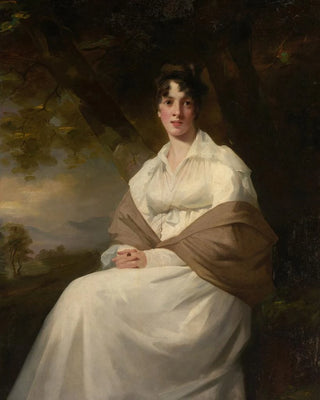Art print | Lady Maitland - Sir Henry Raeburn


View from behind

Frame (optional)
In the fascinating world of 18th-century British painting, the art print "Lady Maitland" by Sir Henry Raeburn stands out for its ability to capture the very essence of its subject. This depiction of Lady Maitland, an iconic figure of Scottish aristocracy, transcends a simple portrait to become a true window into the human soul. Exploring this work reveals not only the beauty of Raeburn's pictorial technique but also a reflection on social status and the role of women in the society of his time. The art print Lady Maitland - Sir Henry Raeburn invites you to immerse yourself in a world where elegance and dignity blend with subtle introspection.
Style and uniqueness of the work
Raeburn's style is characterized by an exceptional mastery of light and color. In "Lady Maitland," he uses rich, warm tones to envelop his subject in an aura of nobility. Lady Maitland's gaze, both serene and penetrating, seems to challenge the viewer, creating an intimate and timeless connection. The composition is carefully balanced, with a dark background that highlights the brightness of the face and clothing of the protagonist. Raeburn manages to infuse his work with rare psychological depth, making each detail meaningful. The drapes of the dress, the reflections of light on the silk, all contribute to a depiction that goes beyond mere physical appearance to touch on the very essence of Lady Maitland's personality.
The artist and his influence
Sir Henry Raeburn, often regarded as Scotland's premier portrait artist, knew how to leave his mark on his era through an innovative approach to painting. Trained in a vibrant artistic environment, he established himself with a personal style that combines realism and idealization. His ability to capture not only the face but also the soul of his models made him an essential figure in portraiture. Raeburn influenced many artists, both through his technique and his vision of human representation. His works continue to inspire current generations, demonstrating the importance of his legacy in art history.

Matte finish

View from behind

Frame (optional)
In the fascinating world of 18th-century British painting, the art print "Lady Maitland" by Sir Henry Raeburn stands out for its ability to capture the very essence of its subject. This depiction of Lady Maitland, an iconic figure of Scottish aristocracy, transcends a simple portrait to become a true window into the human soul. Exploring this work reveals not only the beauty of Raeburn's pictorial technique but also a reflection on social status and the role of women in the society of his time. The art print Lady Maitland - Sir Henry Raeburn invites you to immerse yourself in a world where elegance and dignity blend with subtle introspection.
Style and uniqueness of the work
Raeburn's style is characterized by an exceptional mastery of light and color. In "Lady Maitland," he uses rich, warm tones to envelop his subject in an aura of nobility. Lady Maitland's gaze, both serene and penetrating, seems to challenge the viewer, creating an intimate and timeless connection. The composition is carefully balanced, with a dark background that highlights the brightness of the face and clothing of the protagonist. Raeburn manages to infuse his work with rare psychological depth, making each detail meaningful. The drapes of the dress, the reflections of light on the silk, all contribute to a depiction that goes beyond mere physical appearance to touch on the very essence of Lady Maitland's personality.
The artist and his influence
Sir Henry Raeburn, often regarded as Scotland's premier portrait artist, knew how to leave his mark on his era through an innovative approach to painting. Trained in a vibrant artistic environment, he established himself with a personal style that combines realism and idealization. His ability to capture not only the face but also the soul of his models made him an essential figure in portraiture. Raeburn influenced many artists, both through his technique and his vision of human representation. His works continue to inspire current generations, demonstrating the importance of his legacy in art history.






